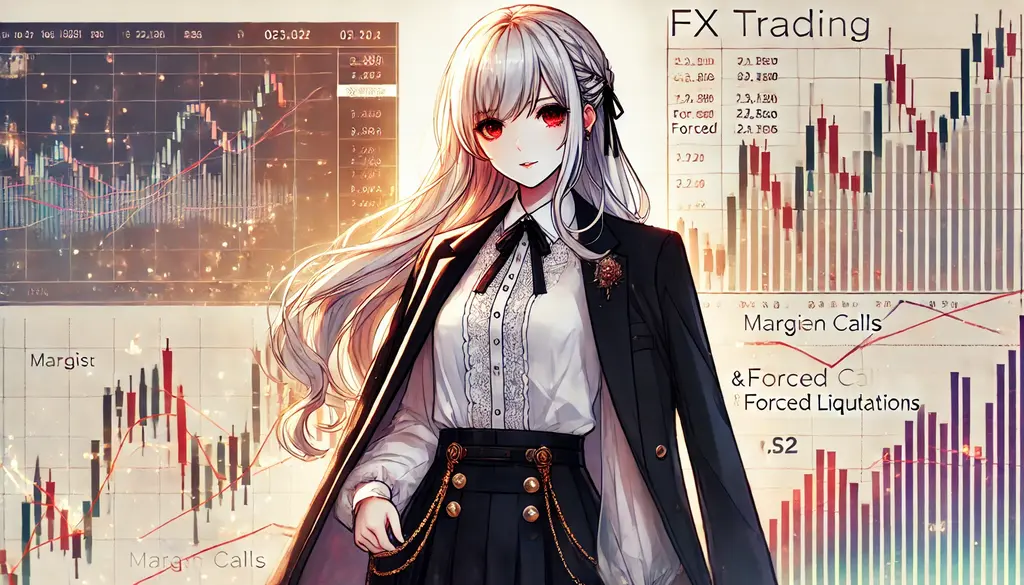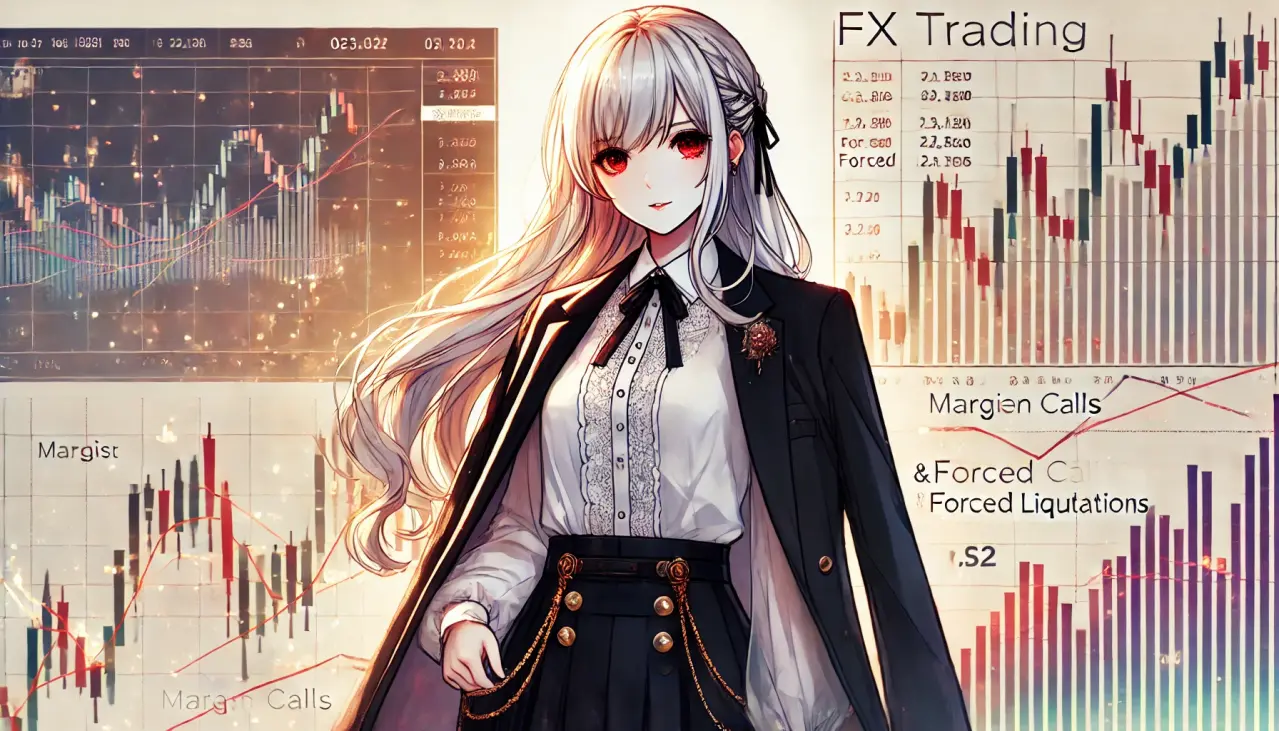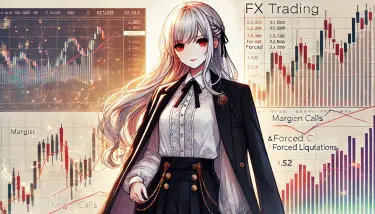How and When Margin Calls Occur
When Margin Calls Happen: Valuation Rate and Maintenance Margin Ratio
In FX trading, the value of a position fluctuates with daily changing rates. When this value falls below a certain threshold, a margin call is triggered. Specifically, this occurs when the maintenance margin ratio drops below a set line.
The maintenance margin ratio is the account’s net asset value (valuation) divided by the required margin for the positions held. When this ratio falls below a certain standard, the FX broker will demand additional margin from the investor. That is the margin call.
The threshold maintenance margin ratio that triggers a margin call varies by FX broker. Generally, many brokers issue a margin call when it falls below 100%, but some will do so when it drops below 50%. Therefore, it is essential to verify the rules of the FX broker you plan to use in advance.
The valuation changes based on the unrealized P&L of the positions held. When the market moves against you, unrealized losses increase and the maintenance margin ratio falls. Thus, margin calls are directly tied to market volatility, and you must constantly monitor market trends.
To avoid margin calls, it is important to maintain an adequate margin balance. Additionally, since a sudden market move can sharply reduce the maintenance margin ratio, you should always keep track of your account status.
Leverage and Margin Calls: Risks of High-Leverage Trading
High-leverage trades can amplify profits, but they also increase the risk of larger losses. The higher the leverage, the more likely a margin call will occur, so caution is warranted.
Leverage allows you to trade large amounts with a small amount of capital. For example, using 100,000 yen of margin to trade 1,000,000 yen results in 10× leverage. By using leverage, you can potentially target large profits even with limited funds.
However, leverage is a double-edged sword and can also magnify losses. If the market moves contrary to your expectation, the loss amount grows in proportion to the leverage multiplier. At that point, the maintenance margin ratio tends to drop, increasing the risk of a margin call.
In particular, high-leverage trading makes the maintenance margin ratio highly sensitive to even small price changes, making margin calls more likely. Therefore, when engaging in high-leverage trades, thorough risk management and maintaining a comfortable margin balance are essential.
Also, when setting high leverage, it is important to place appropriate stop-loss orders to prepare for sudden market moves. By setting stop losses, you can limit losses and reduce the risk of a margin call.
Handling Margin Calls: How to Resolve Them and Key Points
How to Resolve a Margin Call: Depositing Additional Collateral
The most common way to resolve a margin call is to deposit additional collateral by the specified deadline. The amount must exceed the shortfall, and the required sum varies by FX broker.
When a margin call occurs, the FX broker will notify you via email or the trading interface. The notice will include the amount of the margin call and the deposit deadline. If you fail to deposit the specified amount by the deadline, you risk forced liquidation (stop‑loss), so prompt action is essential.
The margin call amount is calculated until the maintenance margin ratio is restored. Some FX brokers set a minimum deposit amount, so check in advance. Also, deposit methods and processing times vary by broker, so be mindful.
When making a deposit to resolve a margin call, it is best to complete the process as quickly as possible. If the market moves further, the margin call amount could increase, so swift funding helps manage risk.
Depositing additional collateral restores the maintenance margin ratio and allows you to keep your positions. When you receive a margin call notice, stay calm and promptly fund the required amount.
Key Points When Resolving a Margin Call: Always Monitor the Maintenance Margin Ratio
To resolve a margin call, it’s crucial to continually monitor the maintenance margin ratio and manage positions appropriately. If you don’t deposit immediately after a margin call, you may face forced liquidation.
Checking the maintenance margin ratio is easy on trading platforms or apps. Check regularly and ensure the ratio stays above a safe threshold. When markets swing sharply, frequent checks are essential.
If a margin call occurs, you must act quickly to fund it, but also verify the maintenance margin ratio afterward. Confirm that the ratio has recovered to a sufficient level, and if needed, consider additional deposits.
To prevent margin calls from occurring, rigorous risk management is essential. When trading, always keep the maintenance margin ratio in mind and use ample capital. Also, watch market movements and cut losses before they widen.
Margin calls are one of the risks in FX trading. However, with proper risk management and swift action, you can minimize losses from a margin call. Always monitor the maintenance margin ratio and trade strategically.

What is Forced Settlement (Stop‑Loss)?
Conditions and Mechanism of Forced Settlement
If margin calls are not resolved, the FX company will forcibly close the customer’s positions. This is called a stop‑loss, a measure to prevent losses from expanding.
A stop‑loss is an automatic settlement process performed by the FX company when the margin maintenance ratio falls below a certain level. If a margin call occurs and is not resolved by the deadline, the FX company will trigger a stop‑loss. This mechanism is designed to keep investors’ losses within a certain range.
The margin maintenance ratio that triggers a stop‑loss varies by FX company. Generally, it is set at a level lower than the level at which a margin call occurs. For example, if a margin call occurs at a maintenance ratio of 100%, the stop‑loss might be set at 50% or 20%.
When a stop‑loss is executed, all held positions are forcibly closed. If a loss has occurred, it is deducted from the account balance. Additionally, a stop‑loss can cause the account balance to become negative. In such cases, the FX company may request additional payment to cover the shortfall.
A stop‑loss is an undesirable outcome for investors. Therefore, it is important to always monitor the margin maintenance ratio and manage positions appropriately to avoid margin calls. Also, enforce thorough risk management and strive to minimize losses.
Timing and Precautions for Forced Settlement: GMO Click Securities’ Safety Valve System (Japan)
The timing of forced settlement varies by FX company. GMO Click Securities uses a proprietary stop‑loss system called the Safety Valve System. To avoid a stop‑loss, pay attention to the margin maintenance ratio.
The Safety Valve System is GMO Click Securities’ proprietary stop‑loss system. In this system, to respond to sudden market movements, it evaluates not only the margin maintenance ratio but also the account balance and position status comprehensively before executing a stop‑loss.
In GMO Click Securities’ Safety Valve System, the margin maintenance ratio that triggers a stop‑loss is not fixed. The timing of a stop‑loss execution varies according to market conditions and account status. Consequently, it can be stricter than other FX companies.
Also, at GMO Click Securities, if a stop‑loss is triggered, all held positions are settled, so caution is required. To prevent a stop‑loss, it is important to keep the margin maintenance ratio consistently high.
Because the timing of a stop‑loss varies by FX company, be sure to check the rules of the FX company you use in advance. In particular, during times when the market may experience sudden volatility, frequently check the margin maintenance ratio and enforce thorough risk management.
To Avoid Margin Calls and Forced Liquidations
The Importance of Risk Management: Planned FX Trading
To avoid margin calls and forced liquidations, risk management is essential. Set stop‑loss levels and choose appropriate leverage to trade deliberately.
Risk management is a crucial factor in FX trading. To avoid margin calls and forced liquidations, first understand your risk tolerance before trading and select appropriate leverage. High‑leverage trades can target large profits but also amplify losses, so caution is needed.
Setting stop‑loss levels is also a key point in risk management. A stop‑loss level is the price range at which you lock in losses if the market moves against your expectation. By setting a stop‑loss, you can prevent losses from widening and reduce the risk of margin calls and forced liquidations.
Also, when trading, keep a close eye on market trends and be mindful of price fluctuations. In particular, during times when markets may swing sharply—such as during economic data releases or key personnel statements—take measures such as adjusting positions or refraining from trading.
Furthermore, regularly review your trade logs to confirm whether your trading style and risk management are appropriate. By analyzing trade records, you can identify areas for improvement and conduct more efficient trades. Trade deliberately and control risk.
Choosing an FX Company: Margin Call Rules and Support Structure
When selecting an FX company, compare margin call rules and support structures. Since margin rules differ among firms—such as FX Neo—choosing a company that fits your trading style is essential.
When choosing an FX company, carefully verify the conditions that trigger margin calls, the deadline for clearing margin, and the forced liquidation rules. Since these rules vary by firm—including the maintenance margin ratio and margin clearance deadlines—selecting a company that aligns with your trading style is crucial.
Additionally, the support structure of an FX company is a key consideration. It is desirable to choose a firm that can provide prompt and courteous support when a margin call occurs or when you have trading questions. Companies offering multiple support channels—phone, email, chat—provide peace of mind.
Moreover, the usability of trading tools and platforms is another important factor in selecting an FX company. To trade smoothly, choose a firm that offers user‑friendly tools and platforms. We recommend trying them out—such as with a demo account—to assess their functionality.
When choosing an FX company, compare several firms and select the one that best matches your trading style and risk tolerance. To minimize the risk of margin calls and forced liquidations, it is essential to choose an FX company carefully.
Reference Sites
毎営業日(祝日を含む)のニューヨーククローズ時点において、時価評価総額が取引金額の4%に相当する日本円額を下回った場合(…
取引日ごとの取引終了時点で、リアルタイム維持率が100%を下回った場合、翌取引日の15:00までに追加証拠金(追証)の入…
追証と強制決済について。FX・外国為替ならGMO外貨【公式サイト】。GMOインターネットグループのFXだから、魅力のスプ…












